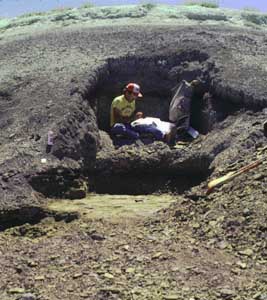
THE PROCESS
of collecting and analyzing plant fossils is arduous. Because fossilized
plant matter is softer than the surrounding rock, wind and weather destroy
it. Wing must dig deep into rocks to discover his fossils.
Furthermore, plants fossilize only under very specific
conditions. "Finding plant fossils is part science, part art, and part
luck," says Wing. "The part that's science is understanding what kinds
of conditions lead to the presence of fossils."
A fallen leaf fossilizes only if it doesn't get eaten
first by earthworms, fungi, ants, or other organisms with a taste for
decaying plants. These organisms prefer moist conditions where there
is also enough oxygen to breathe. If it's too wet, the leaf-eaters suffocate,
leaving the plant to fossilize.
Quickly settling sediments also favor fossilization.
Each layer of sediment protects the leaf from organisms that would destroy
it. So paleobotanists like Wing search for plant fossils in sediment
that was once very wet and accumulated rapidly. Where floods laid down
new earth quickly, layers of sediments are stacked, one on top of the
other, making the rock striped. If earthworms had destroyed the plants,
they also would have churned up the earth, erasing the boundaries between
layers. Wing looks for fossils in dark stripes, because fossil plant
material makes rock dark.
But scientists can look for these visual cues only
if the they can see the rock. That's why they end up working in places
like Wyoming, where much of the land is desert or semi-desert, and erosion
has exposed layers from tens of millions of years ago.
Once scientists have found dark-colored layers of
rock from the geologic time they are studying, they start hunting for
fossils. Wing is interested in the climate of the Paleocene and early
Eocene, so Wyoming makes the perfect place to hunt -- he estimates that
roughly one-third of the exposed rock in the state dates to that time
period.
Using a pick and shovel, Wing collects chunks of
rock the size of toaster ovens, and meticulously labels them by location.
He splits open a rock by hitting it on its edge. Usually it will break
along the surfaces of layers, where the plant fossils hide. If it doesn't,
he has to glue the rock together and try again.
Frequently, Wing says, the Wyoming rocks contain
no plant fossils. But where he does find fossils, "there are often gajillions
of them." Then the hard work begins. Wing must deduce the fossils' species.
And that involves comparing them with other plants, both living and
fossilized, to determine where they fit in. Finally, he uses everything
he can glean about the plant fossils to draw conclusions about the climate
in which they lived.
ONE
WAY of reconstructing paleoclimate is to assume the fossil plant required
the same climate as its nearest living relative does today. Paleontologists'
confidence in that assumption depends on two crucial factors: how
old the fossil is and how unified the living relatives are. Younger
specimens tend to be more straightforward: the more recent the fossil,
the greater its similarity to living relatives. Paleontologists regard
many plants from 55 million years ago -- the era Wing studies -- to
be at the outer limit of the "nearest living relatives" approach.
In addition, groups of living plants with similar
climate requirements provide more information than diverse groups
do about the climates in which their fossilized relatives lived. Oaks,
for instance, reveal little about their ancestors' climate, since
they thrive in many locales with different temperatures. Palm trees,
on the other hand, have much more stringent requirements: none of
the thousands of palm species can survive on soil that freezes. Thus,
when Wing found palm fronds in Wyoming, he concluded that mild winters
were once the rule there. Wing also uses another method to reconstruct
climate, one which does not compare fossils to their living relatives
but instead draws conclusions from the shape of leaves. Both the size
of a leaf and the smoothness of its edges reflect the climate the
plant lives in.
Plants with larger leaves tend to grow in rainy
areas. Wing says that's because "most plants are worried about the
same things: balancing not losing water and getting plenty of light
to make their food." Larger leaves can collect more sunlight, and
so are more efficient at photosynthesis, which converts carbon dioxide
to food. However, larger leaves also let more water escape.
So in very dry areas, such as deserts, plants conserve
their water by growing only small leaves or sometimes no leaves at
all. In wetter locations, such as rainforests, plants can afford to
grow gargantuan leaves, Wing says.
The other shape-based clue to climate rests in
the "teeth" along the edges of leaves. Plants with toothy leaves grow
in cool climates, where the growing season is short. Having teeth
allows increased photosynthesis early in the season. As young leaves
grow, the teeth mature fastest and tend to be most efficient at photosynthesis.
However, teeth also let more water escape. So teeth can present a
problem for a plant living in a warmer environment, where water evaporates
more easily. Plants in hot climes tend to have smooth-edged leaves.
To use these relationships to draw conclusions
about past climates, paleobotantists must again assume that the past
resembled the present, and that leaf shapes of ancient plants reflect
the climate they lived in just as today's leaves do.
The prevalence of smooth margins in Wing's leaf
fossils supports the idea that Wyoming had warm year-round weather
from 57 to 52 million years ago, during the late Paleocene and early
Eocene. However, leaf shape reveals only the average yearly temperature
-- the extremes remain hidden. But since Wing also found fossil ancestors
of palms, he concludes that the weather never dropped below freezing.
The leaf shape method complements the "nearest living relatives" method,
he explains, and they usually agree.
<<
previous || next >>
|

